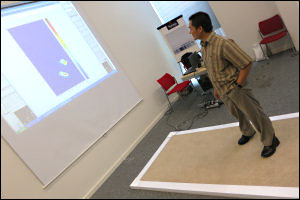
‘Magic Carpet’ Maps Mobility
MANCHESTER, England, Sept. 6, 2012 — Fiber optics could be the key to keeping people with mobility problems on their feet.
A new "smart" carpet has an underlay of plastic optical fibers that bend when walked upon; it can immediately detect when someone has fallen and can help to predict walking patterns, report University of Manchester scientists.

A "smart" carpet developed at the University of Manchester has an underlay of plastic optical fibers that bend when walked upon. It can detect when someone has fallen and can also help predict walking patterns. (Photo: University of Manchester)
Tiny electronics at the carpet's edges act as sensors and relay signals to a computer. These signals can then be analyzed to show the image of the footprint and identify gradual changes in walking behavior as well as sudden incidents such as falling or tripping. They can also show a steady deterioration or change in walking habits, possibly predicting a dramatic episode such as a fall.
As many as 30-40 percent of community-dwelling older people fall each year. This is the most serious and frequent accident in the home and accounts for 50 percent of hospital admissions in the 65 and older age group.
"Falls are a really important problem for our aging society," said professor Chris Todd. "More than a third of older people fall each year, and in nursing and residential homes it is much more common than that."
The scientists say the technology could be used to fit smart carpets in nursing homes, hospital wards and private homes as necessary. Physiotherapists could also use it to map changes and improvements in a person’s gait. “Older people will benefit from exercises to improve balance and muscle strength in the legs," Todd said. "So being able to identify changes in people's walking patterns and gait in the natural environment, such as in a corridor in a nursing home, could really help us identity problems earlier on."
The interdisciplinary team, comprising members of three academic schools and the Photon Science Institute at the university, used a novel tomographic technique similar to that used by hospital scanners: It maps 2-D images using light propagating under the carpet's surface.
The researchers, led by Dr. Patricia Scully of the Photon Science Institute, said the "magic" carpet could be vital not only for helping people in the immediate aftermath of a fall, but also in identifying subtle changes in people’s walking habits that might not be spotted by a family member or caretaker.
“The carpet can gather a wide range of information about a person’s condition, from biomechanical to chemical sensing of body fluids, enabling holistic sensing to provide an environment that detects and responds to changes in patient condition," Scully said. “The carpet can be retrofitted at low cost, to allow living space to adapt as the occupiers’ needs evolve — particularly relevant with an aging population and for those with long-term disabilities — and incorporated non-intrusively into any living space or furniture surface such as a mattress or wall that a patient interacts with.”
The imaging technology is so versatile that it even could be developed to detect the presence of chemical spillages or fire as an early-warning system, the researchers added. They presented their work this week at the Photon 12 conference in Durham City, UK.
For more information, visit: www.manchester.ac.uk
Published: September 2012